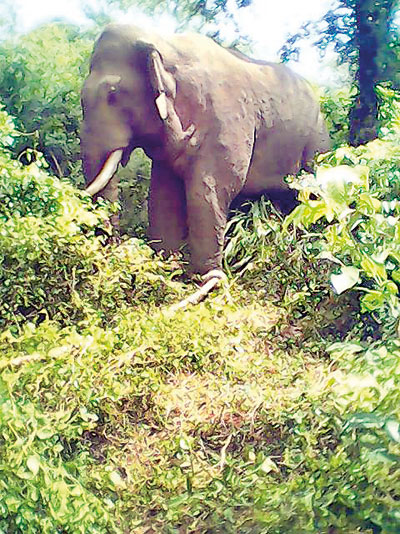News
Parks, monitoring and elephant corridors for safety
The Department of Wildlife Conservation (DWC) has decided to monitor elephants, demarcate parks and create corridors as another measure to minimise the human-elephant conflict and protect the animals, a senior official said.

Nawagattegama Elephant who killed two men captured. Pic Jayarathna Wickramarachchi
The decision was made after the Wildlife Department conceded that a trans-location was not a successful method to address the elephant issue after the recent escape of the single tusked tusker which was released into the elephant holding ground at Horowpathana.
The tusker escaped in the early hours of Wednesday by breaking the electric fencing and started migrating towards his home range at Galgamuwa.
The Director General of the Department of Wildlife Conservation M.G.C. Sooriyabandara said that the department will focus more on preserving elephant home range areas as a solution to the human elephant conflict.
He said that the regional officials and heads of departments were trying to expand and interconnect the elephant corridors to allow elephants to reach from park to park during migration.
“We witnessed the elephants returning to their home ranges from many incidents, this time we have documented well how the one tusked tusker is reaching its familiar surroundings, this is an important scientific finding backed by data,” he said.
He said that they will gather further data by installing more GPS tracking implants on elephants to identify their areas.
“Earlier too a conservator and researcher Dr. Pruthiviraj Fernando collared elephant herds and provided data about elephant home ranges. Therefore with that data over thirty years we are seeking space for the elephant corridor,” he said.
Mr. Suriyabandara pointed out that the solution for the human elephant issue is to remove villagers that brake the elephant corridors and reduce the confrontation of both man and elephant.
“It’s easily said than done, we have to work with multitude of ministries and private institutions to request a small strip of village land for corridors, the process is slow and takes years but we have not given up, the department is focusing on maintaining and expanding the fences marking corridors,” he said.
He said that they have currently installed GPS and radio collars on over fifty elephants and are awaiting 40 more imported collars that are scheduled to be fitted on elephants after tomorrow.

Galgamuwa elephant
He explained that when using collars they are facing some setbacks as the weather proof collars need to be refitted in three years because enclosed batteries cannot be changed and deplete fast when frequencies are increased.
“We also are facing an issue, the department officials don’t know whether it is suitable to anaesthetise elephants frequently, therefore we seek advice from the veterinary surgeons and asses health of individuals an collar several animals from a heard,” he explained.
Mr. Sooriyabandara said that they are seeking ballistic shock sensor equipped collars and the assistance of environmentalists to find better collars which are suited for elephant tracking.
Meanwhile environmentalists expressed mixed reactions about using collars to track elephants.
Environmentalist Shashikalana Ratwatte said that using tracking devices on elephants would be helpful to locate elephants who reach villages. He said that the DWC officials can use recitative data to secure tuskers and at the same time warn the villages about the elephant reaching their way.
He said the Wildlife Department can use collars to identify elephants which are living near human habitation and protect the animals and humans through intervention.
He said that powerful equipment such as collars with ballistic shock sensors and other tracking devices that can detect the location, body temperature and monitor vital signs of elephants would support the preservation of elephants.
The Director of the Environment Conservation Trust Sajeewa Chamikara said that GPS tracking its self does not support elephant conservation.
He stressed that in order to conserve elephants all their habitats need to be protected and a network should be established to link them.
“Currently, a number of issues are bringing down the quality of elephant habitats: Spread of invasive plant species, the frequency of forest fires, a number of development projects fragmenting habitats and the large scale driving of buffaloes and cows into elephant home ranges.”
Mr. Chamikara said 20,000 acres are to be cleared under the Moragahakanda Kalugaga Irrigation project, 10,000 acres from Wasgamuwa and 10,000 from Knuckles and nearby areas. Hambantota too faces significant habitat destruction through the clearing of 15,000 acres for the Magampura port, international conference hall, cricket grounds and highway and handing over land to international corporations.
The GPS collar costs around Rs.1 million per piece, not to mention the cost of catching the animal and sedating it, which demands significant time and money from wild life officers. Added to the risk of the animals dying during the process, this adds up to a significant wastage of funds that are allocated to the Wildlife Authority Mr. Chamikara pointed out.
“The GPS trackers will inform the wild life authorities where the elephants are at a given time and whether they are alive or dead. This is not a solution to either the elephant killings or the elephants coming into villagers. The problem rests with the habitat destruction and funds need to be allocated to solve this problem.” he said
He explained that the elephant death toll increases with the destruction of their habitats.
“When their habitats are destroyed elephants and tuskers frequently visible because they roam from their home ranges or seek food at nearby villagers, then they become targets of poachers,” he said
He pointed out that the proper way to utilise the funds allocated to the wildlife authority is to properly conserve the elephant habitats and take steps to ensure elephants do not roam out of the park by ensuring food and water is abundant in the park.

